Group - Past Activities
2021
June 2021 working paper: our work (with Prashant, et al) entitled STEM: A Stochastic Two-Sided Momentum Algorithm Achieving Near-Optimal Sample and Communication Complexities for Federated Learning has been made available online at [arXiv]; This paper designed a federated learning algorithm which achieves the optimal sample and communication complexity, and characterizes the trade-off between local batch size and local optimization steps.
May 2021 working paper: our work (with Prashant, et al) entitled A near-optimal algorithm for stochastic bilevel optimization via double-momentum has been made available online at [arXiv]; This paper proposes an algorithm which achieves the best sample complexity for certain class of bi-level optimization problem.
May. 2021, paper accepted: our work (with Junyu and Shuzhong) entitled “On lower iteration complexity bounds for the convex concave saddle point problems” has been accepted by Mathematical Programming; paper available at [arXiv];
May. 2021, paper accepted: our work (with Naichen and Dawei and Ruoyu) entitled "RMSprop converges with proper hyper-parameter; has been accepted by ICLR as spotlight ; paper available at [open review];
May. 2021, paper accepted: our work (with Shixiang, Alfredo and Shahin) entitled “Decentralized Riemannian Gradient Descent on the Stiefel Manifold” has been accepted by ICML; paper available at [arXiv];
April. 2021 new preprint (with Bingqing, Wenqiang, Haoran, Sijia) entitled To Supervise or Not To Supervise: How to Effectively Learn Wireless Interference Management Models has been accepted by SPAWC 2021; see the preprint here;
April. 2021 new preprint (with Wenqiang, Xiao, Shahana) entitled Stochastic Mirror Descent for Low-Rank Tensor Decomposition Under Non-Euclidean Losses has been submitted to TSP;
April. 2021 new preprint (with Sagar and Xiao) entitled Deep Spectrum Cartography: Completing Radio Map Tensors Using Learned Neural Models has been submitted to TSP;
Feb. 2021 our work (with Tianyi, Xinwei, Wotao) entitled Hybrid Federated Learning: Algorithms and Implementation has been awarded a Best Student Paper Award in the NeurIPS 2020 Workshop on Scalbility, Privacy, and Security in Federated Learning (NeurIPS-SpicyFL 2020). The paper is online at [arXiv]; Also see the slides here;
2020
Dec. 2020 working paper: our work (with Tianyi, Kaiqing, Han) entitled Asynchronous Advantage Actor Critic: Non-asymptotic Analysis and Linear Speedup has been made available online at [arXiv]; This paper analyzes the complexity of the popular A3C algorithm, and shows that the algorithm's convergence rate (hence efficiency) improves as the number of nodes increases.
Dec. 2020 working paper: our work (with Haoran, Xiao, Wenqiang, Tsung-Hui, Minghe) entitled Learning to Continuously Optimize Wireless Resource In Episodically Dynamic Environment has been made available online at [arXiv]; This paper proposes a new approach based on continuous learning, which helps machine learning based wireless communication strategies to continuously optimize, even when the environment is time-varying. Please see below for our basic system schematic.
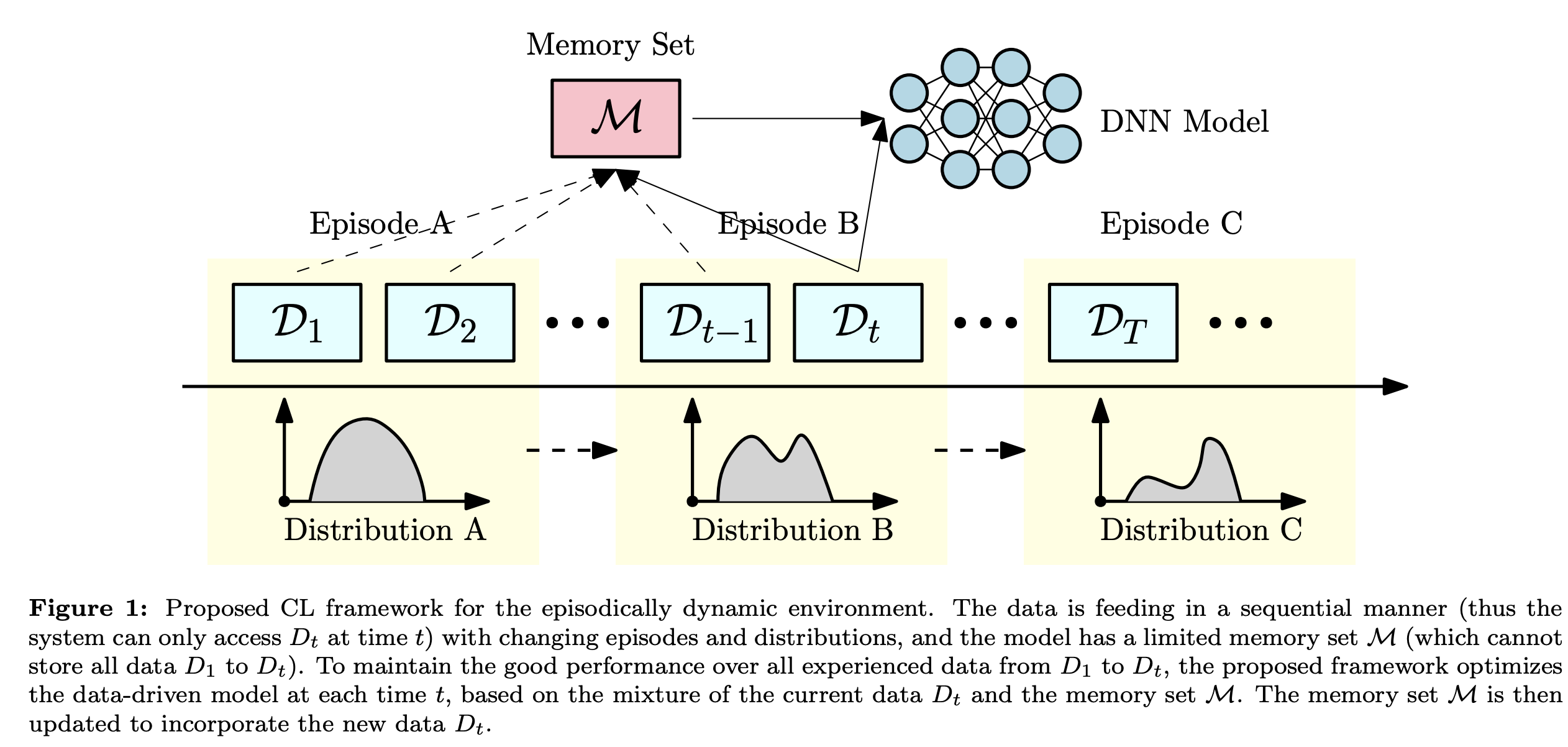 |
Dec. 2020 working paper: our work (with Tianyi, Xinwei, Wotao) entitled Hybrid FL: Algorithms and Implementation has been made available online at [arXiv]; This paper proposes a new formulation, and a novel algorithm for the hybrid Federated Learning setting, where the distributed agents do not share complete data nor features. The proposed algorithm is shown to perform well, and sometimes can outperform centralized algorithms. The setting of the proposed problem is given below.
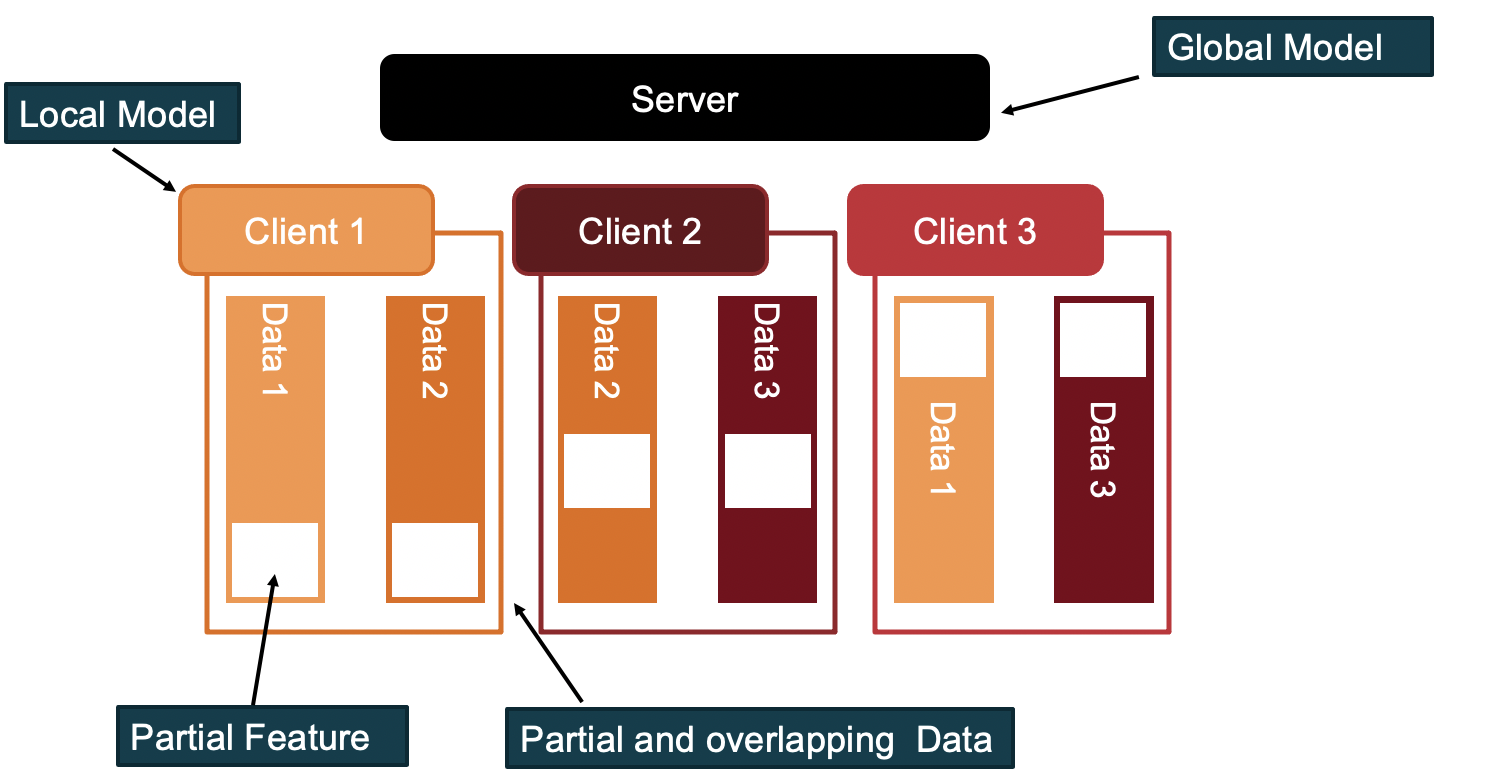 |
Dec. 2020 working paper: our work (with Junyu) entitled First-Order Algorithms Without Lipschitz Gradient: A Sequential Local Optimization Approach has been made available online at [arXiv]; This paper focuses on a class of important optimization, where there is a lack of global Lipschitz gradient. We propose a sequential local optimization framework, which is capable of adapting a number of existing first-order methods, so that they can utilize local Lipschitz continuity to optimize. Numerical results on tensor factorization, linear neural networks all show that the proposed methods are very efficient.
Oct. 2020, paper accepted: our work (with Yi, Ming-Min,and Min-Jian) entitled “Learned conjugate gradient descent network for massive MIMO detection” has been accepted by TSP; The paper develops a novel deep learning based algorithm for solving MIMO detection problem; available at [arXiv];
Sept. 2020, papers accepted in NeurIPS Four papers accepted in NeurIPS, with two as spotlights.
X Chen, ZS Wu, M Hong, Understanding Gradient Clipping in Private SGD: A Geometric Perspective, available at [arXiv] (spotlight)
S Lu, M Razaviyayn, B Yang, K Huang, M Hong, SNAP: Finding Approximate Second-Order Stationary Solutions Efficiently for Non-convex Linearly Constrained Problems, available at [arXiv] (spotlight)
HT Wai, M Hong, Z Wang and Z Yang, Provably Efficient Neural GTD for Off-Policy Learning
X Chen, T Chen, H Sun, ZS Wu, M Hong, Distributed Training with Heterogeneous Data: Bridging Median-and Mean-Based Algorithms, available at [arXiv]
Sept. 2020 Dr. Songtao Lu joined IBM TJ Watson Research Center as a Research Staff.
August. 2020, Best Paper Prize Our 2016 paper on ADMM receives a Best Paper Award (Silver) from ICCM.
August. 2020, Dr. Prashant Khanduri joins the group as a post-doctoral fellow, welcome! [Dr. Khanduri].
July. 2020, IBM Faculty Award: M. receives the [2020 IBM Academic Research Award ] (the previous IBM Faculty Award).
July. 2020, Intel-NSF Research Award: We are one of the 15 teams that receipts the NSF - Intel research award. We propose to understand how to use state-of-the-art optimization and learning tools for wireless communication and networking; this is a joint collaboration with Dr. Dongning Guo at Northwestern University, and Dr. Xiao Fu at Oregon State University; see [the Press Release from Intel], and [in-depth coverage at Forbes.com].
July. 2020 working paper: our work (with Hoi-To, Zhuoran, and Zhaoran) entitled A Two-Timescale Framework for Bilevel Optimization: Complexity Analysis and Application to Actor-Critic has been made available online at [arXiv]; This paper proposes and analyzes two-time scale algorithms for bi-level optimization, and build an interesting connection of the proposed algorithms to actor-critic algorithms in reinforcement learning. In particular, we provide various complexity estimates for two-timescale bi-level optimization. See the image below.
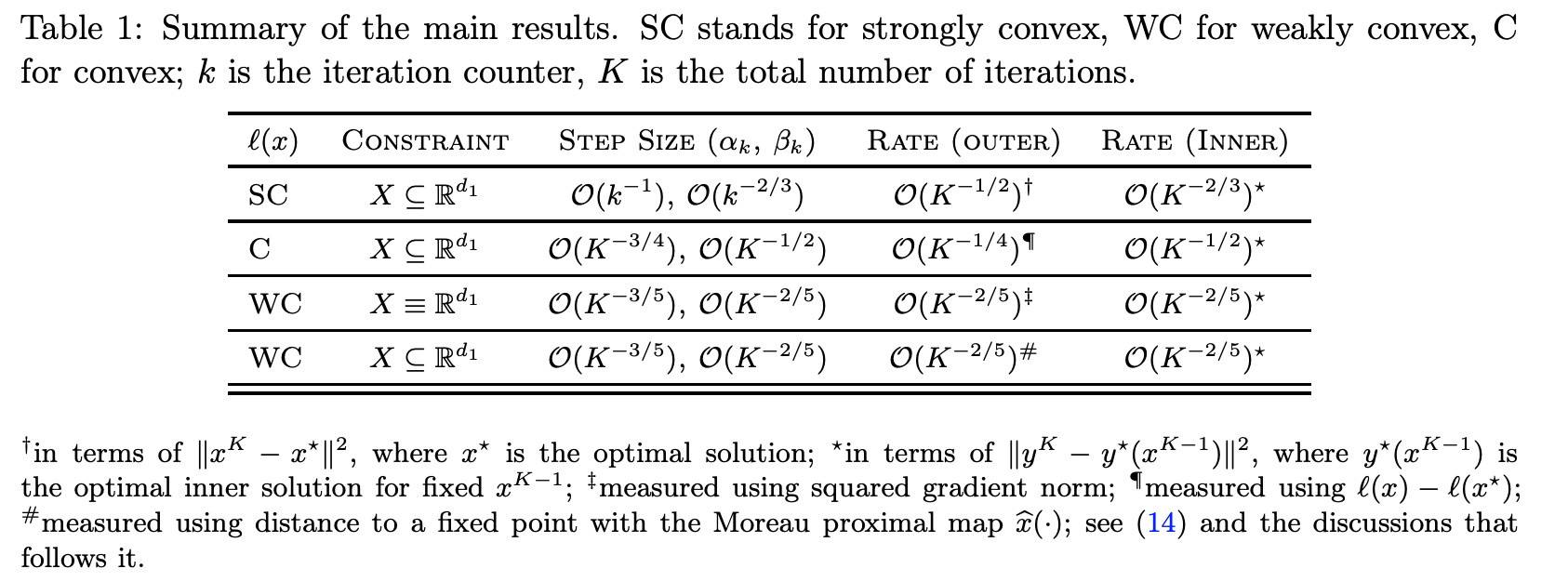 |
June. 2020 working paper: our work (with Junyu, Mengdi, and Shuzhong) entitled Generalization Bounds for Stochastic Saddle Point Problems has been made available online at [arXiv]; This paper studies the generalization bounds for the empirical saddle point (ESP) solution to stochastic saddle point (SSP) problems. For SSP with Lipschitz continuous and strongly convex-strongly concave objective functions, we establish an O(1/n) generalization bound; We also provide generalization bounds under a variety of assumptions, including the cases without strong convexity and without bounded domains. We illustrate our results in two examples: batch policy learning in Markov decision process, and mixed strategy Nash equilibrium estimation for stochastic games. In each of these examples, we show that a regularized ESP solution enjoys a near-optimal sample complexity.
June. 2020 working paper: our work (with Siliang, Haoran, and Junyu) entitled On the Divergence of Decentralized Non-Convex Optimization has been made available online at [arXiv]; We study a generic class of decentralized algorithms in which N agents jointly optimize sum local objectives. By constructing some counter-examples, we show that when certain local Lipschitz conditions (LLC) on the local function gradients are not satisfied, most of the existing decentralized algorithms diverge, even if the global Lipschitz condition (GLC) is satisfied, where the sum function f has Lipschitz gradient. We then design a first-order algorithm, which is capable of computing stationary solutions with neither the LLC nor the GLC. In particular, we show that the proposed algorithm converges sublinearly to certain epsilon-stationary solution, where the precise rate depends on various algorithmic and problem parameters. In particular, if the local functions are Qth order polynomials, then the rate becomes O(1/ϵ^(Qâ1)). Such a rate is tight for the special case of Q=2 where each local function satisfies LLC.
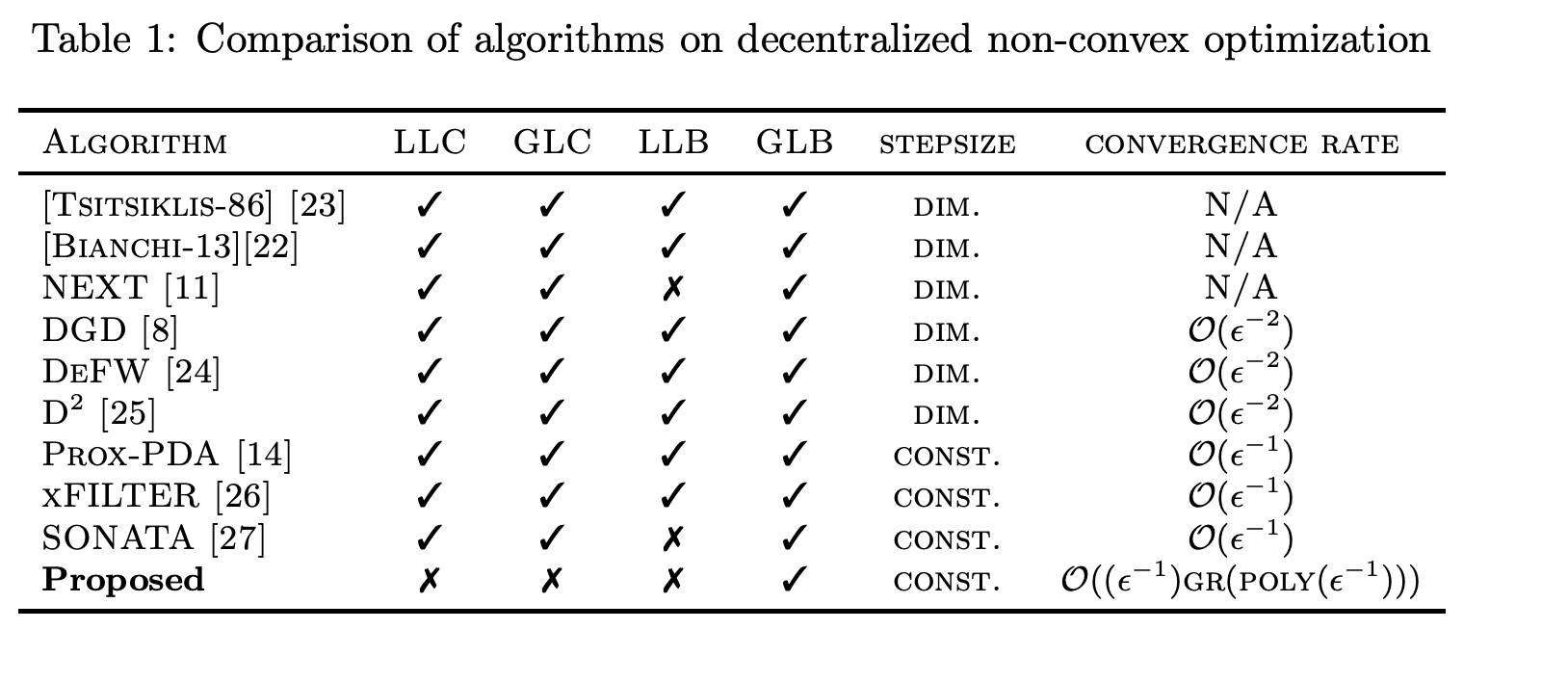 |
June. 2020, Two papers accepted by ICML 2020
Min-Max Optimization without Gradients: Convergence and Applications to Black-Box Evasion and Poisoning Attacks, joint work with Sijia, Songtao (IBM), Xiangyi, Yao Feng (Tsinghua), Kaidi (Northeastern) · Abdullah, Una-May (MIT); We propose a zeroth order-Min-Max algorithm, and apply to certain black-box min-max optimization and black-box evasion and poisoning attacks in adversarial machine learning. available at [arXiv];
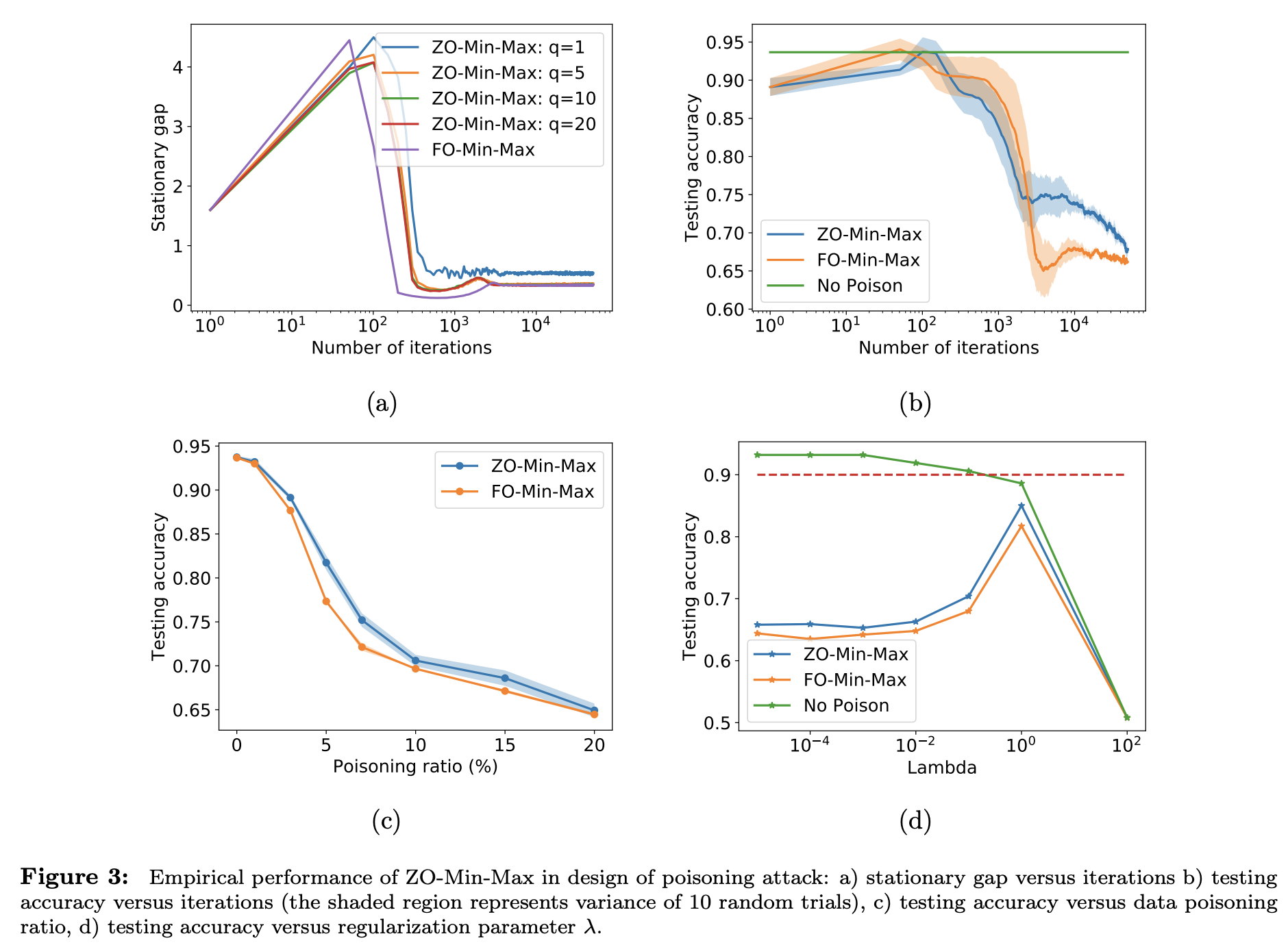 |
-
Improving the Sample and Communication Complexity for Decentralized Non-Convex Optimization: Joint Gradient Estimation and Tracking Joint work with Haoran, Songtao; We proposed an sample, communication and computation efficient algorithm, DGET, for decentralized non-convex optimization; available at [arXiv];
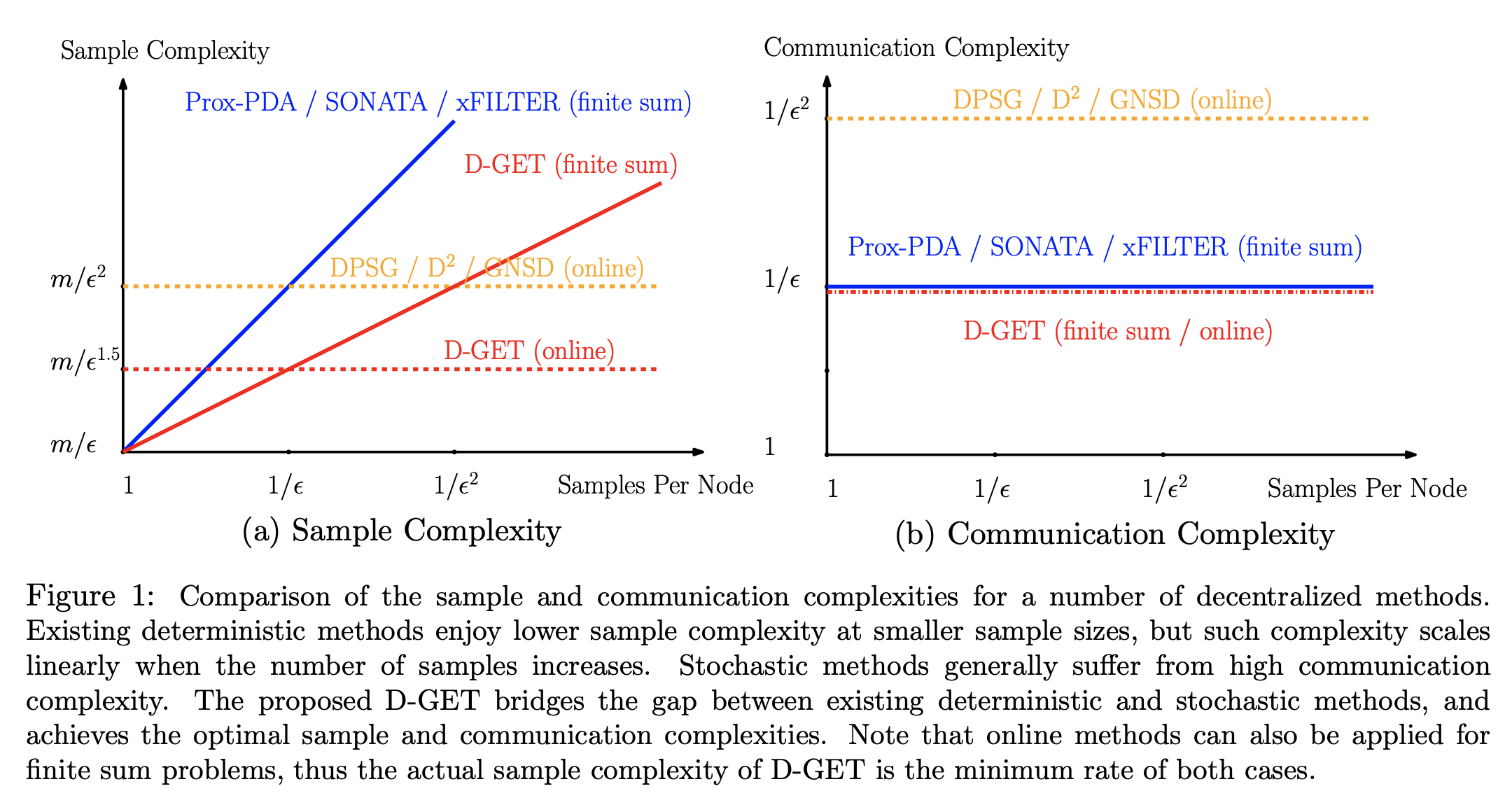 |
June. 2020, Two-part paper accepted: our work (with Qingjiang, Xiao,and Tsung-Hui) entitled “Penalty Dual Decomposition Method For Nonsmooth Nonconvex Optimization, Part I and II” has been accepted by TSP; The paper develops a novel penalty based methods for solving constrained problems arising in signal processing; available at [arXiv];
June. 2020, overview paper accepted: our work (with Meisam, Tianjian, Songtao Mazair and Maher) entitled “Non-convex Min-Max Optimization:Applications, Challenges, and RecentTheoretical Advances ” has been accepted by SPM; The paper provides an overview of recent advances on solving a class of mini-max problem; available at [arXiv];
June. 2020, paper accepted: our work (with Mehmet, Seyed, Burhan, and Steen) entitled “Dense Recurrent Neural Networks for Accelerated MRI: History-Cognizant Unrolling of Optimization Algorithms” has been accepted by JSTSP; The paper proposes a novel physical-driven deep learning method based on unrolling for medical imaging; available at [arXiv];
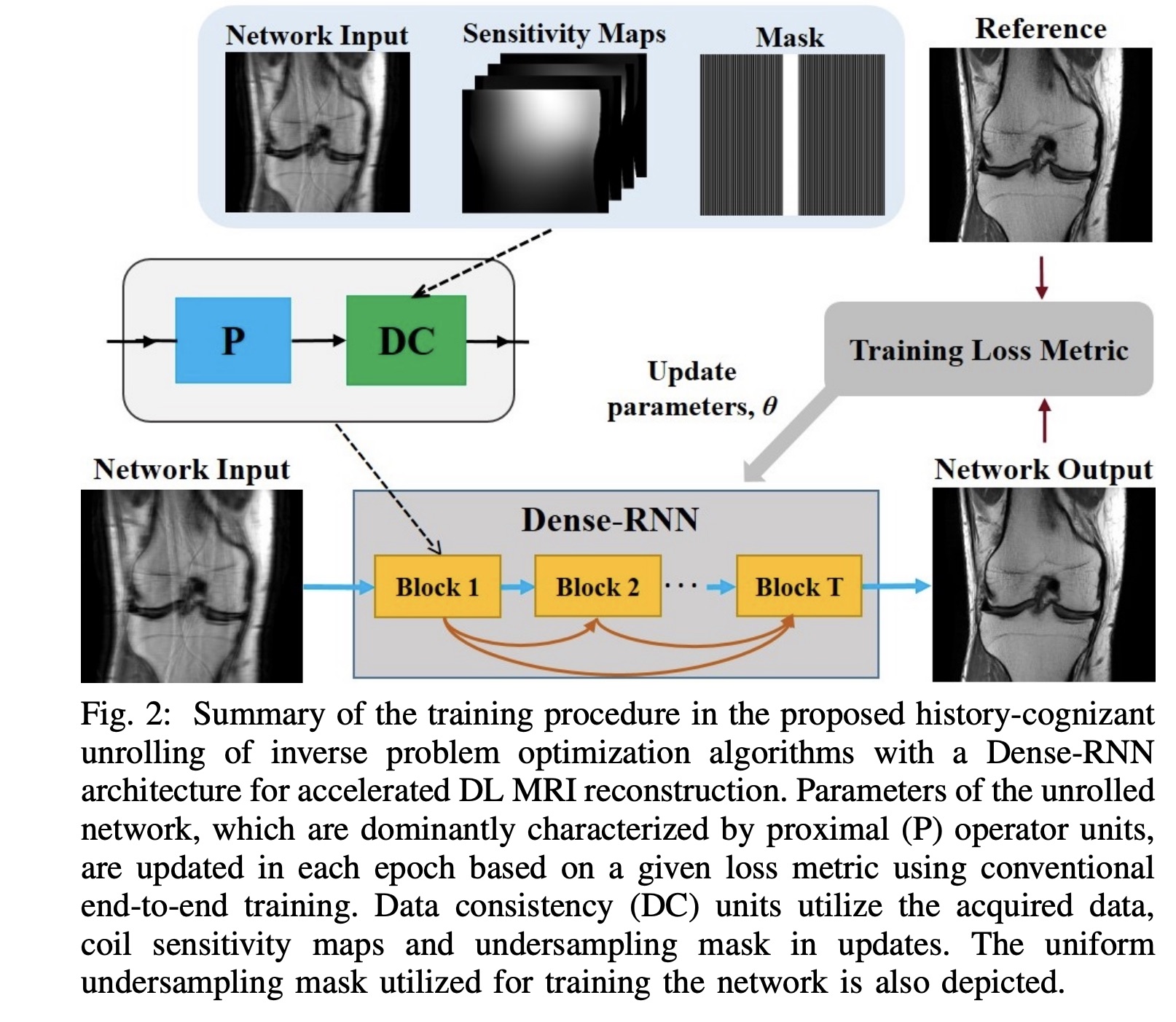 |
May. 2020 working paper: our work (with Xinwei, Sairaj, Wotao and Yang) entitled “Title: FedPD: A Federated Learning Framework with Optimal Rates and Adaptivity to Non-IID Data” has been made available online at [arXiv]; This paper discusses a number of issues with the current federated learning algorithms, especially non-convergence issues, and communication efficiency issues when the data is heterogeneous among the users; it also proposed a primal-dual based algorithm that attempts to resolve those issues. An interesting result is that we show there is a tradeoff between heterogeneity and potential communication savings.
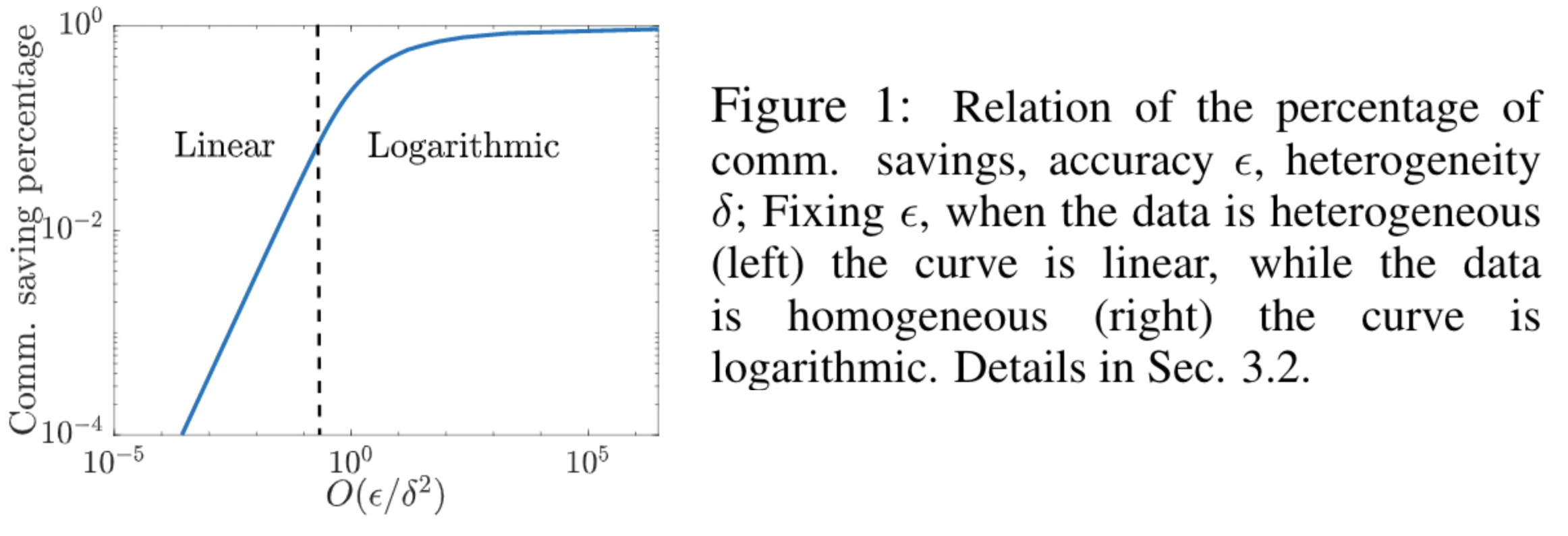 |
April. 2020, paper accepted: our work (with Guoyong,Xiao) entitled “Spectrum Cartography via Coupled Block-Term Tensor Decompositions” has been accepted by TSP; available at [arXiv];
April. 2020, paper accepted: our work (with Kexin,Xiao, et al) entitled “Multi-user Adaptive Video Delivery over Wireless Networks: A Physical Layer Resource-Aware Deep Reinforcement Learning Approach” has been accepted by TCSVT; available at [arXiv];
Feb. 2020, paper accepted: our work (with Songtao, Ioanis and Yongxin) entitled “Hybrid Block Successive Approximation for One-Sided Non-Convex Min-Max Problems: Algorithms and Applications” has been accepted by TSP; available at [arXiv];
Jan. 2020, paper accepted: our survey paper (with Tsung-Hui,Hoi-To, Xinwei and Songtao) entitled “Distributed Learning in the Non-Convex World: From Batch to Streaming Data, and Beyond” has been accepted by IEEE SPM; available at here;
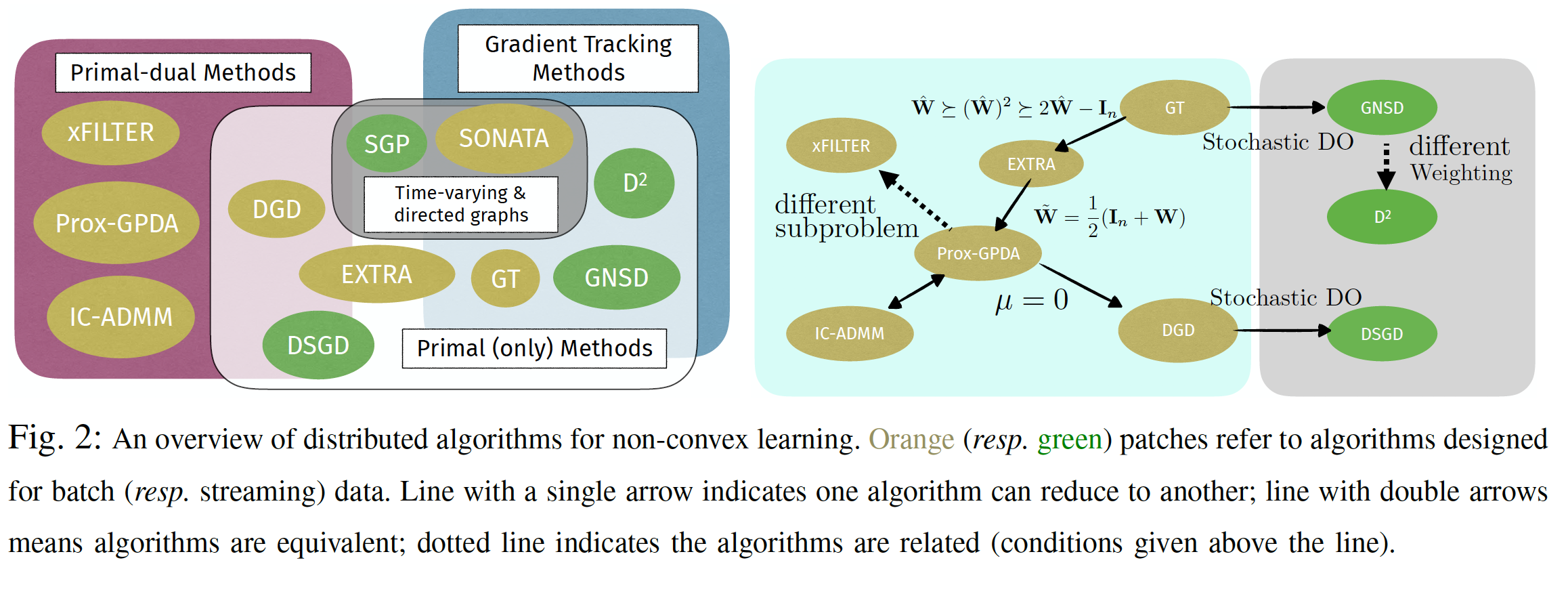 |
2019
Dec. 2019, paper accepted: our paper (with Songtao, Ioanis and Yongxin) entitled “Hybrid Block Successive Approximation for One-Sided Non-Convex Min-Max Problems: Algorithms and Applications” has been accepted by IEEE TSP; available at [arXiv];
Dec. 2019 working paper: our work (with Junyu and Shuzhong) entitled “On Lower Iteration Complexity Bounds for the Saddle Point Problems” has been made available online; available at [arXiv];
Nov. 2019 M. Visited Princeton University (Host: Yuxin Chen and Jason Lee);
Oct. 2019 working paper: our work (with Haoran and Songtao) entitled “Improving the Sample and Communication Complexity for Decentralized Non-Convex Optimization: A Joint Gradient Estimation and Tracking Approach” has been made available online; available at [arXiv];
Sept. 2019 paper accepted: We have 3 papers accepted by NeurIPS 2019; 1) Joint work with Hoi-To, Zhaoran, Zhuoran and Kexin on using Min-Max Analysis for Policy Evaluation; 2) Joint work with Zhuoran, Yongxin, Zhaoran on Global convergence for actor-critic; 3) Joint work with Sijia, Xiangyi, Kaidi, Xingguo, Xue Lin and David on Zeroth-Order Adam method;
Aug. 2019, grant approved: The proposal entitled “Online Modeling of Heterogeneous Autonomy” is funded by AFOSR from 2019-2022. We propose to understand the behavior of autonomous agents by using reinforcement learning;
July. 2019, grant approved: The proposal entitled “CIF: Small: A Simple and Unifying Optimization Framework for Signal and Information Processing Problems with Min-Max Structures” is funded by NSF from 2019-2022. We propose to understand the challenging problem of min-max optimization;
July. 2019 paper accepted: our work (with Haoran and Harish, Aliye and Mike at Bell Labs) entitled Deep Learning Based Preamble Detection and TOA Estimation has been accepted by Globecom2019;
June 2019 paper accepted: our work (with Xiangyi, Sheng, Chao and Mohammadkazem) entitled A Deep Learning Method for Online Capacity Estimation of Lithium-Ion Batteries has been accepted by Journal of Energy Storage;
June 2019 paper accepted: our work (with Haoran) entitled Distributed Non-Convex First-Order Optimization and Information Processing: Lower Complexity Bounds and Rate Optimal Algorithms has been accepted by IEEE TSP;available at [arXiv.org];
June. 2019 M. attended CTW 2019 and presented our work on solving mini-max problems; see [here] for slides;
June. 2019, Songtao presented his work on alternating gradient descent as a long talk in ICML 2019;
May. 2019 paper accepted: our work (with Meisam, Navid and Tom) entitled “A Doubly Stochastic Gauss-Seidel Algorithm for Solving Linear Equations and Certain Convex Minimization Problems” has been accepted by MP series B; available at [arXiv.org];
May. 2019 M. attended ICRL 2019 and presented two papers; see [here] for a blog from IBM about our research on analyzing Adam algorithm for non-convex problems;
April. 2019 paper accepted: our work (with Songtao and Zhengdao) entitled “On the Sublinear Convergence of Randomly Perturbed Alternating Gradient Descent to Second Order Stationary Solutions” has been accepted by ICML 2019; available at [arXiv.org];
Mar. 2019 our work on learning to optimize has been selected as Best Readings in Machine Learning in Communications by ComSoc; see https://www.comsoc.org/publications/best-readings/machine-learning-communications\\[here\\];
Mar. 2019 paper accepted: our work (with Xiangfeng, Shiqian, Meisam, Tsung-Hui and Tom) entitled “A Block Successive Upper Bound Minimization Method of Multipliers for Linearly Constrained Convex Optimization” has been accepted by MOR; available at [Optimization-Online];
Mar. 2019, Xinwei Zhang jointed our group as a Ph.D. student. Thanks Xinwei for deciding to stay with us after working with us since Fall 2018.
Mar. 2019, grant approved: The proposal entitled “Multi-Aspect Intelligence Fusion and Analytics: Models, Identifiability and Computation” (UMN lead, joint with Dr. Xiao Fu at Oregon State) is funded by ARO from 2019-2022. We propose to use novel tensor based optimization methods to deal with multi-aspect data;
Feb. 2019 working paper: our work (with Songtao, Ioanis and Yongxin) entitled “Hybrid Block Successive Approximation for One-Sided Non-Convex Min-Max Problems: Algorithms and Applications” has been made available online; available at [arXiv];
Feb. 2019 three papers accepted by ICASSP 2019;
Jan. 2019 paper accepted: our work (with Davood) entitled “Perturbed Proximal Primal Dual Algorithm for Nonconvex Nonsmooth Optimization” has been accepted by MP Series B;
Dec. 2018 paper accepted: our work (with Xiangyi, Sijia and Ruoyu) entitled “On the Convergence of A Class of Adam-Type Algorithms for Non-Convex Optimization” has been accepted by ICLR 2019; available at [openreview.net];
This paper studies a class of adaptive gradient based momentum algorithms that update the search directions and learning rates simultaneously using past gradients. We develop an analysis framework and a set of mild sufficient conditions that guarantee the convergence of the Adam-type methods, with a convergence rate of order O(log(T)/sqrt(T)) for non-convex stochastic optimization. We show that the conditions are essential, by identifying concrete examples in which violating the conditions makes an algorithm diverge. Besides providing one of the first comprehensive analysis for Adam-type methods in the non-convex setting, our results can also help the practitioners to easily monitor the progress of algorithms and determine their convergence behavior.
Dec. 2018 paper accepted: our work (with Xiangyi, Sijia and Ping-Yu) entitled “signSGD via Zeroth-Order Oracle” has been accepted by ICLR 2019; available at [openreview.net];
2018
Dec. 2018 paper accepted: our work (with Xiangyi, Sijia and Ruoyu) entitled “On the Convergence of A Class of Adam-Type Algorithms for Non-Convex Optimization” has been accepted by ICLR 2019; available at [openreview.net];
This paper studies a class of adaptive gradient based momentum algorithms that update the search directions and learning rates simultaneously using past gradients. We develop an analysis framework and a set of mild sufficient conditions that guarantee the convergence of the Adam-type methods, with a convergence rate of order O(log(T)/sqrt(T)) for non-convex stochastic optimization. We show that the conditions are essential, by identifying concrete examples in which violating the conditions makes an algorithm diverge. Besides providing one of the first comprehensive analysis for Adam-type methods in the non-convex setting, our results can also help the practitioners to easily monitor the progress of algorithms and determine their convergence behavior.
Dec. 2018 paper accepted: our work (with Xiangyi, Sijia and Ping-Yu) entitled “signSGD via Zeroth-Order Oracle” has been accepted by ICLR 2019; available at [openreview.net];
Nov. 2018 distinguished talk: M. has presented a distinguished lecture about zeroth-order optimization for adversary machine learning, at [GlobalSIP 2018 Symposium on SP for Adversary ML];
Nov. 2018 M. attended the GlobalSIP 2018 as an co-organizer for the [Distributed Learning and Optimization over Networks];
Nov. 2018 M. visited LIDS, Harvard EE, and IBM AI Lab;
Oct. 2018 working paper (with Ioannis and Songtao) entitled “Block Alternating Optimization for Non-Convex Min-Max Problems: Algorithms and Applications in Signal Processing and Communications” has been submitted for publication, see paper [here]. ;
In this work, we consider a general block-wise one-sided non-convex minmax problem, in which the minimization problem consists of multiple blocks and is non-convex, while the maximization problem is concave. This problem arises in many SP and Comm applications, such as max-min utility maximization problem, robust learning problem, and a wireless communication problem in the presence of jammers.
 |
We propose two simple algorithms, which alternatingly perform one gradient descent-type step for each minimization block and one gradient ascent-type step for the maximization problem. We show that such simple alternating min-max algorithms converge to first-order stationary solutions with global sublinear rate.
Oct. 2018 best paper award: Haoran has received a best student paper prize (third prize) for our paper “Distributed Non-Convex First-Order Optimization and Information Processing: Lower Complexity Bounds and Rate Optimal Algorithms” in Asilomar 2018;
Sept. 2018 working paper (with Songtao, Xiangyi, Yongxin and Rahu) entitled “Understand the dynamics of GANs via Primal-Dual Optimization” has been submitted for publication;
Sept. 2018 paper accepted: our work (with Zhuoran, Kaiqing and Tamer) entitled “A Finite Sample Analysis of the Actor-Critic Algorithm” has been accepted by CDC 2018; available at [arXiv.org];
Sept. 2018 paper accepted: our work (with Charilaos, Xiao, Nikos) entitled “Structured SUMCOR Multiview Canonical Correlation Analysis for Large-Scale Data” has been accepted by TSP; available at [arXiv.org];
Sept. 2018 paper accepted: our work (with Hoi-To, Zhuoran, Zhaoran) entitled “Multi-Agent Reinforcement Learning via Double Averaging Primal-Dual Optimization” has been accepted by NIPS 2018; available at [arXiv.org];
Aug. 2018 paper accepted: our work (with Haoran) entitled “Distributed Non-Convex First-Order Optimization and Information Processing: Lower Complexity Bounds and Rate Optimal Algorithms” has been accepted by Asilomar 2018, as one of the best student paper finalists; Full version available at [arXiv.org];
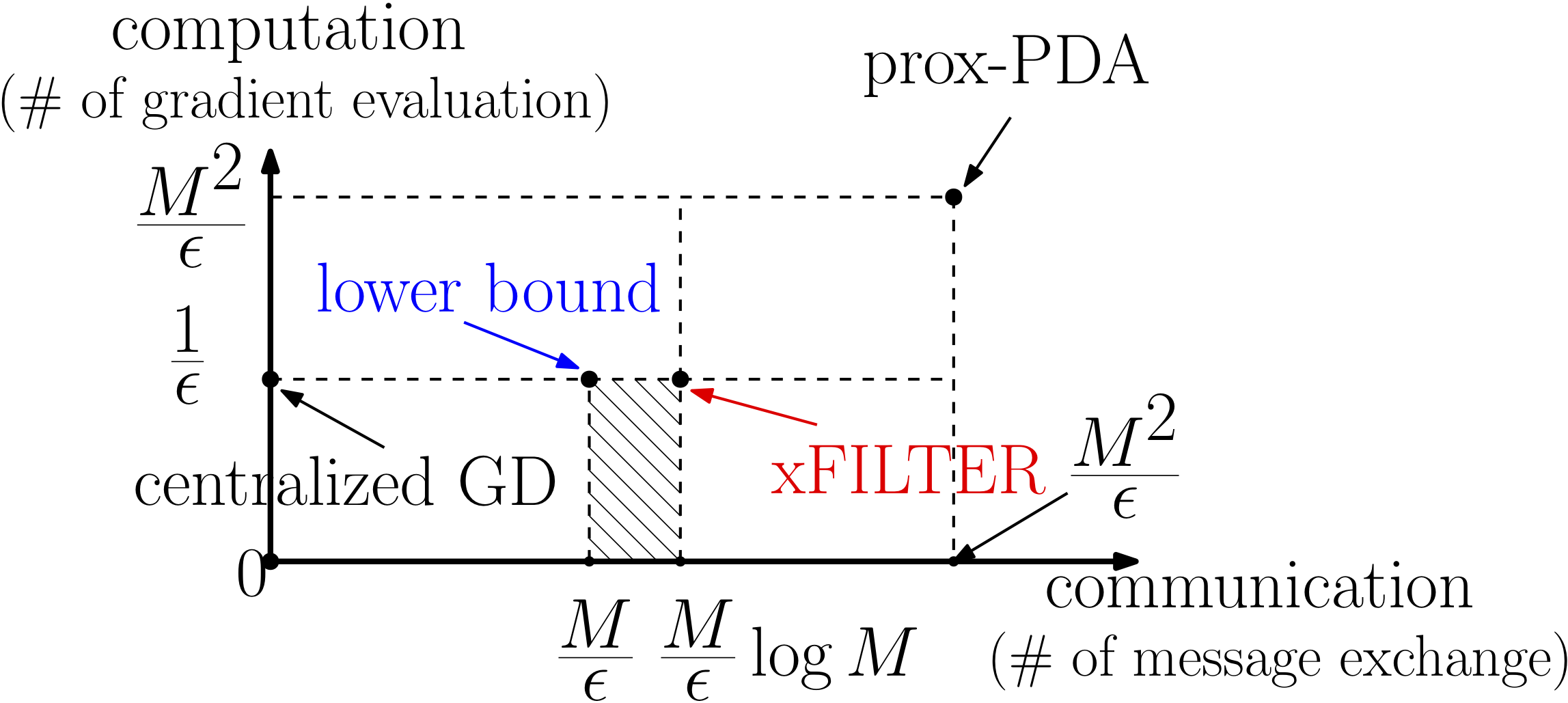 |
This paper discusses the fundamental performance for distributed non-convex optimization, where multiple nodes collectively optimize some non-convex function using local data. For a class of non-convex problems, we develop an “optimal” distributed algorithm called xFILTER, in the sense that it achieves the best possible convergence rate for a class of first-order distributed algorithms. In the left figure, we illustrate the results derived in this paper (both the lower bound and xFILTER bound), by comparing them with the rates of an non-optimal D-GPDA method, and the centralized gradient descent (GD) methods (over a path graph with M nodes, to achieve certain |
Aug. 2018 M. attended 2018 Workshop On New Computing-Driven Opportunities for Optimization and gave talks on ‘‘Optimization and Signal processing".
May. 2018 paper accepted: our work (with Haoran, Xiangyi, Qingjiang, Xiao and Nikos) entitled “Learning to Optimize: Training Deep Neural Networks for Wireless Resource Management” has been accepted by IEEE TSP; available at [arXiv.org]; Prof. Nikos Sidiropoulos (ECE at University of Virginia) gave a Keynote at ICC Workshop ‘‘Machine Learning for Communications’’ about this paper. See the slides here.
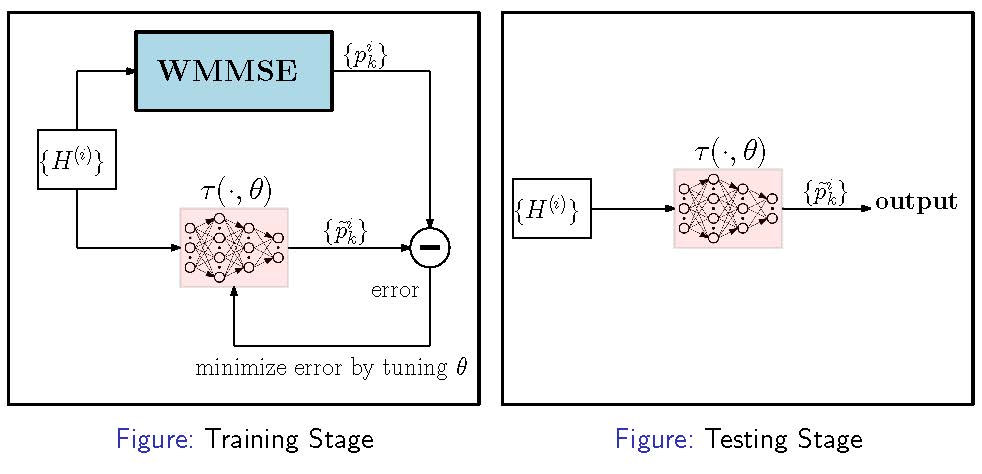
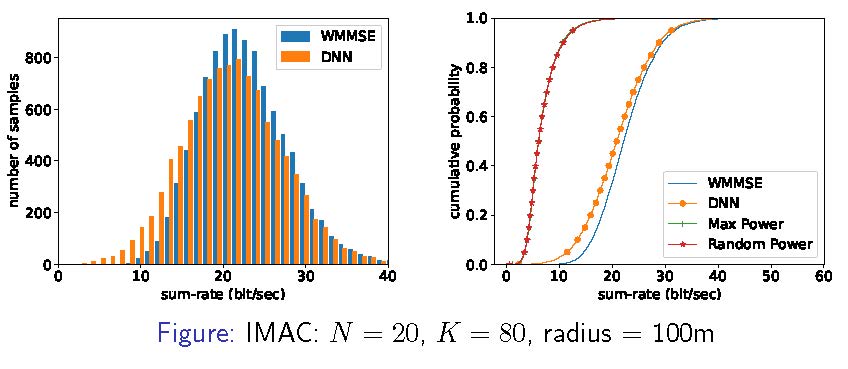
May. 2018 M. visited ECE at Carnegie Mellon University and gave talks on ‘‘Rate Optimal Methods for Distributed Non-Convex Optimization and Learning"; Host Prof. Jose Moura.
May. 2018 paper accepted: our work (with Jason and Meisam) entitled “Gradient Primal-Dual Algorithm Converges to Second-Order Stationary Solutions for Nonconvex Distributed Optimization” has accepted by ICML 2018; available at [arXiv.org];
Apr. 2018 Dr. Hoi To Wai from Arizona State University has visited our group for a week.
Apr. 2017 working paper (with Haoran) entitled “Distributed Non-Convex First-Order Optimization and Information Processing: Lower Complexity Bounds and Rate Optimal Algorithms”; available at [arXiv.org];
Apr. 2018 paper accepted: our work (with Xiao, Kejun, Nikos and Qingjiang) entitled “Anchor-Free Correlated Topic Modeling” has been accepted by IEEE Transactions on Pattern Analysis and Machine Intelligence for publication;
Apr. 2018 M. visited WID at University Wisconsin-Madison and gave talks on ‘‘Rate Optimal Methods for Distributed Non-Convex Optimization and Learning". Host Prof. Steve Wright.
Mar. 2018 paper accepted: our work (with Qingjiang) entitled “Spectral Efficiency Optimization For Millimeter Wave Multi-User MIMO Systems” has been accepted by IEEE Journal on Selected Topics in Signal Processing for publication; available at [arXiv.org];
Mar. 2018 M. attended CISS 2018 and INFORMS Optimization Society Meeting and gave talks on ‘‘Rate Optimal Methods for Distributed Non-Convex Optimization and Learning".
Feb. 2018 Mr. Ziping Zhao from Hong Kong University of Science and Technology, Prof. Daniel Palomar"s group has joined our group as a visiting student; Welcome Ziping!
Feb. 2018 working paper (with Songtao and Zhengdao) entitled “On the Sublinear Convergence of Randomly Perturbed Alternating Gradient Descent to Second Order Stationary Solutions” has been submitted for publication; available at [arXiv.org];
Feb. 2018 working paper (with Meisam and Jason) entitled “Gradient Primal-Dual Algorithm Converges to Second-Order Stationary Solutions for Nonconvex Distributed Optimization” has submitted for publication; available at [arXiv.org];
Feb. 2018 M. attended 2018 Zurich Seminar and have a talk on ‘‘Learning based Approach for Non-Convex Optimization and Resource Allocation"
Jan. 2018, M. visited EECS Department at Northwestern University and gave a talk on ‘‘Distributed and Learning based Approach for Non-Convex Optimization". Host Prof. Ermin Wei.
Jan. 2018, M. gave a talk in IMA data science seminar on ‘‘Distributed and Learning based Approach for Non-Convex Optimization"
Jan. 2018, M. , with Qing, Serhat, and Tom is organizing a Symposium for GlobalSIP 2018, entitled “Distributed Optimization and Learning over Networks”. The conference is to be held Nov 26-28th in Anaheim, CA, and the submission deadline is tentatively June 10th, 2018
Jan. 2018, M. , with Xiao and Nikos, is organizing a special session for SPAWC 2018, entitled “Machine Learning for Communications”. The conference is to be held June 25-28th in Kalamata, Greece
2017
Dec. 2017, M. visited Ken Ma“s group at CUHK and gave a talk on ‘‘Distributed and Learning based Approach for Non-Convex Optimization”
Dec. 2017, M. gave an invited talk at 2017 International Workshop on Mathematical Issues in Information Sciences (MIIS), at CUHK Shenzhen
Dec. 2017, working two-part paper (first-part with Qingjiang, second-part with Qingjiang, Tsung-Hui and Xiao) entitled “Penalty Dual Decomposition Method For Nonsmooth Nonconvex Optimization” has submitted for publication; available at [arXiv.org];
Nov. 2017, Davood has successfully defended his thesis, congratulations! ; After the defense, he will join Duke University for a postdoc.
Nov. 2017, M. becomes a member of [IEEE MLSP Technical Committee], from 2018 - 2020.
Nov. 2017, working paper (joint work with Davood) entitled “Perturbed Proximal Primal Dual Algorithm for Nonconvex Nonsmooth Optimization” has submitted for publication.
Oct. 2017, working paper (joint work with Haoran, Xiangyi, Qingjiang, Xiao and Nikos) entitled “Learning to Optimize: Training Deep Neural Networks for Wireless Resource Management” has submitted for publication; available at [arXiv.org] [code].
August. 2017, paper accepted: our paper (joint work with Nan, Tsung-Hui, Ya-Feng, Hamid and Tom) entitled “Network Slicing for Service-Oriented Networks Under Resource Constraints” has been conditionally accepted by IEEE JSAC.
Aug. 2017, grant approved: The proposal entitled “Decomposition Framework for Non-convex Nonsmooth Optimization with Applications in Data Analytics” is funded by NSF CMMI from 2017-2021 (Grant No. CMMI-1727757). We propose to use novel primal-dual methods to deal with non-convex optimization problems arise in many modern data analytics problems.
Aug. 2017 I am hiring a new post-doctoral fellow in the area of optimization and/or statistical learning and/or signal and information processing. Please contact me if you are interested.
Aug. 2017 I am moving to the ECE Department, University of Minnesota as an Assistant Professor in Fall 2017. I am very excited to start this new position and am thankful for the wonderful experience that I had in Iowa State!
July. 2017, M. gave an invited talk at the Wireless Broadband Department, Huawei Research Institute, Shanghai
July. 2017, M. gave an invited talk at the Mathematics Department, Sichuan University
July. 2017, M. gave an invited talk at University of Electronic Science and Technology at China
June. 2017, paper accepted: our paper (joint work with Wei-Cheng, Hamid, and Tom) entitled “A Distributed Semi-Asynchronous Algorithm for Network Traffic Engineering” has been conditionally accepted by IEEE SIPN.
May. 2017, paper accepted: our paper (joint work with Qingjiang, Haoran, Songtao and Meisam) entitled “Inexact Block Coordinate Descent Methods For Symmetric Nonnegative Matrix Factorization” (available at [arXiv.org]) has been conditionally accepted by IEEE TSP.
May. 2017, M. attended [Conference on Nonconvex Statistical Learning 2017], held at USC.
May. 2017, M. attended [SIAM Conference on Optimization]. Our minisymposium on Large-Scale optimization and data analytics has been very successful. Thanks for all the participants!
May. 2017, two papers accepted: our papers entitled “Towards K-means-friendly Spaces: Simultaneous Deep Learning and Clustering” (available at [arXiv.org]), and “A Proximal Primal-Dual Algorithm for Fast Distributed Nonconvex Optimization and Learning Over Networks”, are accepted by ICML 2017.
Apr. 2017, Songtao has been awarded a Graduate College"s Research Excellence Award, congratulations!
Apr. 2017, paper accepted: journal paper (joint work with Xiao, Kejun, Anthony and Nikos), entitled “Scalable and Optimal Generalized Canonical Correlation Analysis via Alternating Optimization” has been accepted by IEEE TSP; available at [arXiv.org].
Mar. 2017, working paper (joint work with Nan, Ya-Feng, Hamid, Tsung-Hui and Tom) entitled “Network Slicing for Service-Oriented Networks Under Resource Constraints” has been submitted for publication.
In this work, we consider the “network slicing” for 5G systems, which is to optimally locate the service functions in the physical network and allocate the network resources while satisfying multiple service requirements specified by the service function chains, subject to link and node capacity constraints. We propose a number of highly efficient optimization based algorithms and study their performance.
Mar. 2017, M. visited the ECE Department of University of Minnesota
Mar. 2017, working paper (joint work with Davood and Alfredo) entitled “Zeroth Order Nonconvex Multi-Agent Optimization over Networks” has been submitted for publication.
In this work, we propose a novel distributed algorithm (over connected graphs) for non-convex optimization, in the challenging scenario where each agent can only access the zeroth-order information (i.e., the functional values) of its local functions.
Mar. 2017, working paper (joint work with Haoran, Xiangyi, Qingjiang, Xiao and Nikos) entitled “Learning to Optimize: Training Deep Neural Networks for Wireless Resource Management” has submitted for publication.
In this work, we propose a new learning-based approach for wireless resource management. The key idea is to treat the input and output of a resource allocation algorithm as an unknown non-linear mapping and to use a deep neural network (DNN) to approximate it. The paper is available at [arXiv.org].
Mar. 2017, M. visited the ECE Department of UC Davis
Mar. 2017 Qingjiang has completed his one-year research appointment and returned China. Thanks Qingjiang for all his contribution to our group!
Mar. 2017, M., Qingjiang, Songtao and Xiangyi attended ICASSP 2017 at New Orleans
Feb. 2017, Dr. Tsung-Hui Chang from CUHK Shenzhen visited our group.
Feb. 2017, M. visited the IE Department of the Texas A&M University
Feb. 2017, M. , with Dr. Qing Ling, Dr. Serhat Aybat, Dr. Tom Luo and Dr. Amir Asif is organizing a Symposium for GlobalSIP 2017, entitled “Distributed Optimization and Resource Management over Networks”. The conference is to be held Nov 14-16th in Montreal, Canada, and the submission deadline is tentatively May 15th, 2017
Feb. 2017, Grant approved: Our group has received an NVIDIA GPU Grant.
Jan. 2017, paper accepted: journal paper (joint work with Songtao and Zhengdao), entitled “A Nonconvex Splitting Method for Symmetric Nonnegative Matrix Factorization: Convergence Analysis and Optimality” has been conditionally accepted by IEEE TSP.
Jan. 2017, paper accepted: conference paper (joint work with Songtao and Zhengdao), entitled “A Stochastic Nonconvex Splitting Method for Symmetric Nonnegative Matrix Factorization, ” has been accepted by AISTATS.
Jan. 2017, paper accepted: journal paper (joint work with Yijian, Emiliano, Sairaj and Zi), entitled “Distributed Controllers Seeking AC Optimal Power Flow Solutions Using ADMM” has been conditionally accepted by IEEE TSG.
Jan. 2017, Davood has been awarded a Graduate College"s Research Excellence Award, congratulations!
Jan. 2017, paper accepted: journal paper (joint work with Tsung-Hui), entitled “Stochastic Proximal Gradient Consensus Over Random Networks” has been conditionally accepted by IEEE TSP; paper available at [arXiv.org].
Jan. 2017, M. becomes a member of [IEEE SPCOM Technical Committee], from 2017 - 2019.
Jan. 2017, Qingjiang has became an Associated Editor for [IEEE Transactions on Signal Processing], congratulations!
2016
Dec. 2016, M. attended the GlobalSIP 2016 as an co-organizer for the [Symposium on Distributed Information Processing, Optimization, and Resource Management over Networks].
Nov 2016, paper accepted: journal paper, entitled “A Distributed, Asynchronous and Incremental Algorithm for Nonconvex Optimization: An ADMM Approach” has been accepted by TCNS.
Nov 2016, paper accepted: journal paper (joint work with Mingmin, Yunlong, etc), entitled “Joint Transceiver Designs for Full-Duplex K-Pair MIMO Interference Channel with SWIPT” has been accepted by TCOM.
Nov. 2016, working paper (joint work with Qingjiang) entitled “Spectral Efficiency Optimization For mmWave Multiuser MIMO Systems”, has been submitted for publication. In this work, we propose a novel optimization based non-convex algorithm to deal with multi-user hybrid precoding problem that arise in the emerging massive MIMO systems.
Nov. 2016, M. becomes an elected member of [IEEE SPCOM Technical Committee] , from 2017 - 2019.
Oct. 2016, working paper (joint work with Bo, Xiao and Nicholas) entitled “Towards K-means-friendly Spaces: Simultaneous Deep Learning and Clustering”, has been available at [arXiv.org], [code].
Sept. 2016, submitted 4 papers to ICASSP 2016.
Sept. 2016, working paper (joint work with Haoran, Xiangyi, Qingjiang and Xiao) entitled “Learning to Optimize: Training Deep Neural Networks for Wireless Resource Management” has been available at [PDF] [code]. In this work, we propose a new learning-based approach for wireless resource management. The key idea is to treat the input and output of a resource allocation algorithm as an unknown non-linear mapping and to use a deep neural network (DNN) to approximate it.
August 2016, M. visited Princeton University, and gave a talk in the Statistical Machine Learning Group Seminar (host: Dr. Han Liu)
August 2016, paper accepted: conference paper (joint work with Davood, Tuo and Zhaoran), entitled “NESTT: A Nonconvex Primal-Dual Splitting Method for Distributed and Stochastic Optimization” has been accepted by NIPS 2016; available at [arXiv.org].
August 2016, paper accepted: conference paper (joint work with Ming-min and Qingjiang), entitled “A Distributed Algorithm For Dictionary Learning over Networks” has been accepted by GlobalSIP 2016.
August, 2016, best paper prize finalist: M. gave an invited talk in [International Conference on Continuous Optimization (ICCOPT)] 2016, as a Finalist of the Best Paper Prize for Young Researchers in Continuous Optimization; [Slides]
August 2016, paper accepted: Journal paper (joint work with Qingjiang, et al), entitled “Joint Source-Relay Design for Full–Duplex MIMO AF Relay Systems”, accepted by TSP;
July 2016, paper accepted: Journal paper (joint work with Xiangfeng, Tom and Meisam), entitled “Iterations Complexity Analysis of Block Coordinate Descent Method”, accepted by MPA; available at [arXiv.org]
June, 2016, M. gave an invited 2-day short course on modern optimization and decomposition methods, in [Modern Optimization and Applications (MOA)] 2016, held at the Chinese Academy of Sciences, Beijing.
June 2016, working paper (joint work with Qingjiang, Haoran, Songtao and Meisam) entitled “Inexact Block Coordinate Descent Methods For Symmetric Nonnegative Matrix Factorization” has been available at [arXiv.org] [code]. In this work we design block coordinate descent based algorithms for solving symmetric non-negative matrix factorization problems, and perform theoretical analysis of convergence and rate of convergence. We also apply the derived methods to document clustering problems.
May 2016, working paper (joint work with Xiao, Kejun, Nikos and Anthony) entitled “Scalable and Optimal Generalized Canonical Correlation Analysis via Alternating Optimization” has been available at [arXiv.org]. This paper designs a fast, memory efficient and computationally lighweight algorithm for high-dimensional generalized (multiview) canonical correlation analysis (GCCA) for large-scale datasets. Simulations and large-scale word embedding tasks are employed to showcase the effectiveness of the proposed algorithm.
May 2016, working paper (joint work with Xingguo, Jarvis, Raman, Han and Tuo) entitled “A First Order Free Lunch for SQRT-Lasso” has been available at [arXiv.org]. In this paper, we study the fundamental tradeoff between computation and statistical estimation robustness through a SQRT-Lasso problem for sparse linear regression and sparse precision matrix estimation in high dimensions. We explain how novel optimization techniques help address these computational challenges.
May 2016, working paper (by Davood, M., Zhaoran and Tuo) entitled “NESTT: A Nonconvex Primal-Dual Splitting Method for Distributed and Stochastic Optimization” has been available at [arXiv.org]. We study a stochastic and distributed algorithm for nonconvex problems whose objective consists of a sum of N nonconvex functions, plus a nonsmooth regularizer. The proposed NonconvEx primal-dual SpliTTing (NESTT) algorithm splits the problem into N subproblems, and utilizes an augmented Lagrangian based primal-dual scheme to solve it in a distributed and stochastic manner. We show that the proposed algorithm achieves fast convergence, under a novel non-uniform sampling scheme. Further, we reveal a fundamental connection between primal-dual based methods and a few primal only methods such as IAG/SAG/SAGA
May. 2016, paper accepted: journal paper (joint work with Tom), entitled “On the Linear Convergence of the Alternating Direction Method of Multipliers”, accepted by MPA; available at [arXiv.org]
May 2016, M. visited IMA to attend the workshop on Resource Trade-offs: Computation, Communication, and Information
Apr. 2016, M. visited Purdue University (host: Dr. Aldo Scutari)
Apr. 2016, paper accepted: conference paper (joint work with Chao Hu et al), entitled “On-Board Analysis of Degradation Mechanisms of Lithium-Ion Battery using Differential Voltage Analysis”, accepted by ASME IDETCT conference. In this work, we study reliability of lithium-ion (Li-ion) rechargeable batteries. This work proposes a methodological framework for on-board quantitative analysis of degradation mechanisms of Li-ion battery using differential voltage analysis. Simulation results obtained from LiCoO2/graphite Li-ion cells verify the effectiveness of the proposed framework in online estimation of the degradation parameters.
Apr. 2016, working paper entitled “Decomposing Nonconvex Problems Using a Proximal Primal-Dual Approach: Algorithms, Convergence, and Applications” has been available at [arXiv.org]
Apr. 2016, M. is organizing an invited session for INFORMS 2016 under the Big Data Cluster
Apr. 2016, M. visited The University of Alabama and gave a talk about the analysis of Block Coordinate Descent at the Applied Math Seminar (host: Dr. Brendan Ames)
Mar. 2016, M. attended ICASSP 2016 in Shanghai
Mar. 2016, M. and Dr. Qing Ling are organizing a session for the 50th Asiloar Conference on Signal, Systems and Computers 2016, on “Distributed Optimization”.
Mar. 2016, M. attended the Shenzhen Research Institute of Big Data First Workshop of Data Science
Mar. 2016, working paper (joint work with Qingjiang et al) entitled “Joint Source-Relay Design for Full–Duplex MIMO AF Relay Systems” has been submitted for journal publication
Mar. 2016, paper accepted: journal paper (joint work with Ya-Feng and Enbing), entitled “Sample Approximation-Based Deflation Approaches for Chance SINR Constrained Joint Power and Admission Control”, accepted by TWC; available at [arXiv.org]
Feb. 2016, M. visited Arizona State University and gave a talk in the Network Science Seminar.
Feb. 2016, M. , with Dr. Qing Ling, Dr. Serhat Aybat and Dr. Tom Luo is organizing a Symposium for GlobalSIP 2016, entitled “Distributed Optimization and Resource Management over Networks”.
Feb. 2016, Dr. Qingjiang Shi has joined the group as a Post-Doctoral Research Fellow; Welcome!
Jan. 2016, M. attended the IMA workshop on Optimization and Parsimonious Modeling at University of Minnesota.
Jan. 2016, paper accepted: journal paper (joint work with Tsung-Hui, Xiangfeng and Wei-Cheng), entitled “Asynchronous Distributed ADMM for Large-Scale Optimization- Part I: Algorithm and Convergence Analysis”, accepted by TSP; available at [arXiv.org]
Jan. 2016, paper accepted: journal paper (joint work with Tsung-Hui, Xiangfeng and Wei-Cheng), entitled “Asynchronous Distributed ADMM for Large-Scale Optimization- Part I: Algorithm and Convergence Analysis”, accepted by TSP; available at [arXiv.org]
Dec. 2015, paper accepted: four papers have been accepted by ICASSP 2016
Dec. 2015, paper accepted: conference paper (joint work with Xingguo, Tuo Zhao, Raman and Han entitled ‘‘An Improved Convergence Analysis of Cyclic Block Coordinate Descent-type Methods for Strongly Convex Minimization", has been accepted by AISTATS 2016
Dec. 2015, working paper (joint work with Ruoyu) entitled “Improved Iteration Complexity Bounds of Cyclic Block Coordinate Descent for Convex Problems” is online; available at [arXiv.org]
Dec. 2015, M. gave a talk at the Computer Science Department, Center for Language And Speech Processing Seminar, The Johns Hopkins University.
Dec., 2015, Davood gave a talk in GlobalSIP 2015, [slides]
Dec. 2015, M. attended NIPS 2015. Presented our work on improved iteration complexity analysis for cyclic BCD algorithm (joint work with Ruoyu); see the technical report available at [arXiv.org]
2015
Dec, 2015, paper accepted: four papers have been accepted by ICASSP 2016
Dec, 2015, paper accepted: conference paper (joint work with Xingguo, Tuo Zhao, Raman and Han entitled ‘‘An Improved Convergence Analysis of Cyclic Block Coordinate Descent-type Methods for Strongly Convex Minimization", has been accepted by AISTATS 2016
Dec., 2015, working paper (joint work with Ruoyu) entitled “Improved Iteration Complexity Bounds of Cyclic Block Coordinate Descent for Convex Problems” is online; available at [arXiv.org]
Dec., 2015, M. gave a talk at the Computer Science Department, Center for Language And Speech Processing Seminar, The Johns Hopkins University.
Dec., 2015, Davood gave a talk in GlobalSIP 2015, [slides]
Dec., 2015, M. attended NIPS 2015. Presented our work on improved iteration complexity analysis for cyclic BCD algorithm (joint work with Ruoyu); see the technical report available at [arXiv.org]
Nov., 2015, working paper (joint work with Tsung-Hui) entitled “Stochastic Proximal Gradient Consensus Over Random Networks” is online; available at [arXiv.org]
Nov, 2015, paper accepted: journal paper (joint work with Brendan) entitled “Alternating direction method of multipliers for penalized zero-variance discriminant analysis” has been accepted by Computational Optimization and Applications (COAP); available at [arXiv.org]
Nov, 2015, paper accepted: journal paper (joint work with Meisam and Tom) entitled “Convergence Analysis of Alternating Direction Method of Multipliers for a Family of Nonconvex Problems” has been accepted by SIAM Journal on Optimization; available at [arXiv.org]
Oct., 2015, M. organized the session “Recent Advanced in First Order Methods for Large-Scale Optimization” at INFORMS 2015; also gave two talks
Oct., 2015, paper accepted: journal paper (joint work with Meisam, Qingjiang and Tom) entitled SINR Constrained Beamforming for a MIMO Multi-user Downlink System" has been accepted by TSP (with minor revision); available at [arXiv.org]
Oct., 2015, M. gave a talk at the Computer Science Department, University of Iowa, entitled “A Unified Framework for Large-Scale Block-Structured Optimization”
Oct., 2015, M. gave an invited talk at Allerton 2015 on distributed and stochastic optimization over random graph
Oct., 2015, project started: collaborative project entitled “Distributed inverter controllers seeking reliability and economic-optimality of photovoltaic-dominant distribution systems” has been started; this is a 2-year joint project with NREL
Oct., 2015, paper accepted: journal paper (joint work with Ya-feng and Qiang) entitled “Decomposition by Successive Convex Approximation: A Unifying Approach for Linear Transceiver Design in Heterogeneous Networks” has been accepted by IEEE Transactions on Wireless Communication; available at [arXiv.org]
Sept., 2015, papers submitted to ICASSP 2016
Sept., 2015, Davood awarded a student Travel Fellowship from GlobalSIP ; congratulations!
Sept., 2015, Haoran awarded a Presidential Fellowship ; congratulations!
Sept., 2015, grant approved: Collaborative proposal entitled “Mechanism Design for Complex Systems: A Black-box Model Approach” is funded by AFOSR;
Sept., 2015, paper accepted: conference paper (joint work with Ruoyu) entitled “Improved Iteration Complexity Bounds of Cyclic Block Coordinate Descent for Convex Problems” has been accepted by NIPS
Aug, 2015, paper accepted: journal paper (joint work with Meisam, Tom and Jong-Shi) entitled “A Unified Framework for Large-Scale Block-Structured Optimization Involving Big Data” has been accepted by IEEE Signal Processing Magazine as a Feature Article; available at [arXiv.org]
Aug., 2015, grant approved: Collaborative proposal entitled “Optimal Provision of Backhaul and Radio Access Networks: A Cross-Network Approach” is funded by NSF CCF; for more details please see [here].
Aug, 2015, paper accepted: journal paper (joint work with Qingjiang et al) entitled “Energy Efficiency Optimization for MISO SWIPT Systems With Zero-Forcing Beamforming” has been accepted by IEEE Transactions on Signal Processing; available at [IEEE Xplore]
Aug., 2015, paper submitted: journal paper (joint paper with Qingjiang, Meisam and Tom) entitled “SINR Constrained Beamforming for a MIMO Multi-user Downlink System”, has been submitted for publication.
Aug., 2015, M. gave a talk at ISEE, Zhejiang University, China
July-Aug., 2015, M. visited Dr. Ya-Feng Liu, The State Key Laboratory of Scientific and Engineering Computing, the Chinese Academy of Sciences
July, 2015, M. attended ISMP 2015 and gave a talk on nonconvex ADMM
May-June, 2015, M. visited Chinese University of Hong Kong (ShenZhen)
Jun 2015, paper submitted: journal paper (joint work with Tsung-Hui, Xiangfeng and Wei-Cheng), entitled “Asynchronous Distributed ADMM for Large-Scale Optimization- Part I: Algorithm and Convergence Analysis”,submitted for publication; available at [arXiv.org]
Jun 2015, paper submitted: journal paper (joint work with Tsung-Hui, Xiangfeng and Wei-Cheng), entitled “Asynchronous Distributed ADMM for Large-Scale Optimization- Part I: Algorithm and Convergence Analysis”,submitted for publication; available at [arXiv.org]
May, 2015, M. obtained new appointment: joint (courtesy) appointment, Department of ECpE, Iowa State University
May, 2015, M. presented our work on BSUM and its applications in a seminar in the Department of ECpE, Iowa State University
Apr., 2015, M. presented 3 papers in ICASSP 2015. See here for the slides of our work on large-scale back-haul traffic engineering.
Apr., 2015, paper submitted: journal paper (joint paper with Andy and Tom ) entitled “Monaural Speech Enhancement: Estimating Ideal Ratio Mask by Sparse NMF and DNN” has been submitted for publication. In this work we proposed an algorithm based on Nonnegative Matrix Factorization (NMF), or Sparse Dictionary Learning, and Deep Neural Networks (DNN) to extract features for natural speech and perform speech enhancement.
Mar, 2015, paper accepted: journal paper (joint work with Alfredo) entitled “Efficient Rate Allocation in Wireless Networks Under Incomplete Information” has been accepted by IEEE Transactions on Automatic Control
Mar., 2015, paper submitted: journal paper (joint paper with Andy, Tom and researchers in Starkey Labs.) entitled “Wiener Filtering and Sparse NMF: A New Approach for Single Channel Speech Enhancement” has been submitted for publication.
Mar., 2015, M. attended NSF CISE Career Workshop (Thanks ISU Engineering School for providing partial funding support)
Mar., 2015, paper submitted: Journal paper entitled “A Unified Algorithmic Framework for Block-Structured Optimization Involving Big Data” has been submitted for journal publication.
Feb, 2015, paper accepted: journal paper (joint work with Ruoyu and Tom) entitled “Joint Downlink Base Station Association and Power Control for Max-Min Fairness Computation and Complexity” has been accepted by IEEE JSAC special issue on Special Issue on Recent Advances in Heterogenous Cellular Networks; available at [arXiv.org]
Feb., 2015, paper submitted: Journal paper entitled “Energy Efficiency Optimization For MISO SWIPT Systems With Zero-Forcing Beamforming” has been submitted for journal publication.
Jan., 2015, M. is awarded Faculty Foreign Travel Grant by ISU faculty senate.
Jan., 2015, M. started a new course: Modern Big Data Optimization
Jan., 2015, paper accepted: Four papers are accepted by ICASSP 2015
2014
Dec, 2014, paper submitted: journal paper entitled “A Distributed, Asynchronous and Incremental Algorithm for Nonconvex Optimization: An ADMM Based Approach” has been submitted for publication. This paper discusses an asynchronous and incremental ADMM implementation for solving certain class of nonconvex optimization problems.
Dec. 2014, attended NIPS 2015, presented a poster at the main conference and a poster at the workshop of optimization for machine learning
Nov 2014, gave a talk at the graduate seminar, IMSE Department at Iowa State.
Nov 2014, visited University of Houston ECE Department, presented our work on BSUM-M algorithm convex/nonconvex ADMM; Served as committee member for Dr. Lanchao Liu
Nov 2014, attended INFORMS annual meeting at San Francisco; presented our work on BSUM-M algorithm
Nov., 2014, paper accepted: Our paper on nonconvex ADMM has been accepted by NIPS OPT Workshop.
Oct., 2014, paper accepted: Journal paper (joint work with Tsung-Hui and Xiangfeng) entitled “Multi-Agent Distributed Optimization via Inexact Consensus ADMM”, has been accepted by IEEE TSP.
Oct, 2014, paper submitted: journal paper (joint work with Tom and Meisam) entitled “Convergence Analysis of Alternating Direction Method of Multipliers for a family of Nonconvex Problems” has been submitted for publication
Oct., 2014ï¼ five papers submitted to ICASSP 2015: We have summarized our recent works on cloud radio networking, nonconvex ADMM, hearing aids design, speech signal processing into five ICASSP submissions:
Oct, 2014, paper submitted: conference paper (joint work with Tom and Meisam) entitled “Convergence Analysis of Alternating Direction Method of Multipliers for a family of Nonconvex Problems” has been submitted to ICASSP; This paper (as well as its journal version to be uploaded soon), is the first work that analyzes the ADMM algorithm for nonconvex problems, without making any assumptions on the iterates. We show that for a family of consensus and sharing problems, the classical ADMM as well as many of its variants (i.e., randomized , proximal, essentially cyclic) converge to the stationary solution as long as the stepsize is chosen to be large enough (with computable bounds). Also see here for a presentation made by Tom earlier in the summer.
Sept., 2014, I am awarded a Black & Veatch Faculty Fellowship, by the College of Engineering, Iowa State (2014-2017)
Sept., 2014, paper presented: Tom presented our work on convex/nonconvex ADMM in 2014 Workshop on Optimization for Modern Computation; see here for the slides
Sept., 2014, paper accepted: conference paper (joint work with Meisam, Tom and Jong-Shi) entitled “Parallel Successive Convex Approximation for Nonsmooth Nonconvex Optimization” has been accepted by NIPS 2014
Aug., 2014, New course offering: IE 312 Optimization; see here for course website; permission required.
Aug., 2014, I started as an Assistant Professor at Iowa State University.
July, 2014, paper submitted: journal paper (joint work with Ruoyu and Tom) entitled “Joint Downlink Base Station Association and Power Control for Max-Min Fairness Computation and Complexity” has been submitted for publication. This paper systematically studies the downlink user-BS association and power control problem in a HetNet. Interestingly, we found that under certain assumptions on the receive SNR, the seemingly difficult combinatorial problem can be solved very efficiently (i.e., in polynomial time).
June, 2014, paper submitted: conference paper (joint work with Meisam, Tom and Jong-Shi) entitled “Parallel Successive Convex Approximation for Nonsmooth Nonconvex Optimization” has been submitted for publication. This paper develops various parallel schemes (with flexible coordinate selection rules) to solve a large number of convex and nonconvex nonsmooth problems arise in optimizing large-scale problems; iteration complexity analysis for both convex and nonconvex cases is provided.
June, 2014, paper submitted: conference paper (joint work with Andy and Tom) entitled “Combining Sparse NMF with Deep Neural Network: A New Classification-Based Approach for Speech Enhancement” has been submitted for publication.
June, 2014, paper accepted: Survey paper (joint work with Hadi, Meisam, Mazair, Ruoyu, Wei-cheng and Tom ) entitled “Cross-Layer Provisioning of Future Cellular Networks”, has been accepted by IEEEãSignal Processing Magazine, special issue on the 5G revolution. This work outlines several theoretical and practical aspects of joint interference management and network provisioning for future cellular networks. A cross-layer optimization framework is proposed for joint user admission, user-base station association, power control, user grouping, transceiver design as well as routing and flow control.
May, 2014, attended SIAM conference on Optimization, 14 at San Diego; presented our work on iteration complexity analysis of BCD and the BSUM-M algorithm; see the slides
May, 2014, paper accepted: Journal paper (joint work with Shuai and others ) entitled “Outage Constrained Robust Secure Transmission for MISO Wiretap Channels” has been accepted by TWireless.
May, 2014, paper accepted: Journal paper (joint work with Wei-Cheng, Tom and researchers from Huawei Canada) entitled “Min Flow Rate Maximization for Software Defined Radio Access Networks” has been accepted by IEEE JSAC, special issue on 5G systems.
May, 2014, paper accepted: Conference paper (joint work with Maziar, Meisam and Tom) entitled “Joint Base Station Clustering and Beamformer Design for Partial Coordinated Transmission using Statistical Channel State Information” has been accepted by IEEE SPAWC; This paper proposes a partial joint transmission scheme for HetNet based on the long-term channel distribution information (CDI). The main tool used is the SSUM algorithm for stochastic nonsmooth optimization.
Apr., 2014, paper accepted: Journal paper (joint work with Wei-Cheng, Ya-Feng and Tom) entitled “Base Station Activation and Linear Transceiver Design for Optimal Resource Management in Heterogeneous Networks” has been accepted by IEEE TSP (with minor revision).
Apr., 2014, paper accepted: Journal paper (joint work with Zi and Tom) entitled “Semidefinite approximation for mixed binary quadratically constrained quadratic programs”ï¼has been accepted by SIOPT; We studied the performance bounds for using semidefinite relaxation methods for a family of quadratic problems with both binary and continuous variables.
Mar., 2014, paper accepted: Journal paper (joint work with Joaquin, Alfredo and Ana) entitled “Interference Pricing Mechanism for Downlink Multicell Coordinated Beamforming” has been accepted by IEEE TCOM
Jan.- Mar., 2014, gave talks at Texas Tech University, University of Massachusetts, New Jersey Institute of Technology, Iowa State University and Oregon State University
Jan., 2014, paper submitted: Journal paper (joint work with Tsung-Hui, Xiangfeng, Shiqian, Meisam and Tom) entitled “A Block Successive Upper Bound Minimization Method of Multipliers for Linearly Constrained Convex Optimization”, has been submitted for publication. This paper proposes a family of algorithms for convex linearly constrained problems, with multiple block variables. The algorithm alternates between optimizing certain approximate Augmented Lagrangian Functions and an inexact dual ascent step. The algorithm is flexible to allows both cyclic and randomized update of the block variables. Application areas include signal processing, wireless networking and smart grid provisioning.
Jan., 2014, paper submitted: Journal paper (joint work with Wei-Cheng, Meisam, Mazair, Ruoyu, Tom and researchers from Huawei Canada) entitled “Cross-Layer Provisioning of Future Cellular Networks”, has been submitted for publication. This work outlines several theoretical and practical aspects of joint interference management and network provisioning for future cellular networks. A cross-layer optimization framework is proposed for joint user admission, user-base station association, power control, user grouping, transceiver design as well as routing and flow control.
Jan., 2014, paper submitted: Journal paper (joint work with Brendan) entitled “Alternating direction method of multipliers for sparse zero-variance discriminant analysis and principal component analysis”, has been submitted for publication. This paper considers the task of classification in the high-dimensional setting where the number of features of the given data is significantly greater than the number of observations. We develop the method of sparse zero-variance discriminant analysis (SZVD) to simultaneously perform linear discriminant analysis and feature selection on high-dimensional data.
Jan. 2014, I have been promoted to Research Assistant Professor.
2013
Dec., 2013, paper submitted: Journal paper (joint work with Tsung-Hui and Xiangfeng) entitled “Multi-Agent Distributed Optimization via Inexact Consensus ADMM”, has been submitted to IEEE TSP. This paper proposes a scheme that is able to approximate the entire augmented Lagrangian during the ADMM iterations, which makes the ADMM algorithm very simple for problems with complicated structures. We show that in the application of distributed sparse Logistic Regression, our scheme can reduce the overall computational complexity by an order of magnitude, comparing with traditional consensus methods.
Dec., 2013ï¼paper submitted: Journal paper (joint work with Wei-Cheng, Tom and researchers from Huawei Canada) entitled “Min Flow Rate Maximization for Software Defined Radio Access Networks” has been submitted to IEEE JSAC. This paper proposes an interesting large-scale parallel optimization scheme, which can efficiently route a large number of traffic while performing wireless resource allocation, for the future software defined radio access network (SD-RAN); The scheme is based on a combination of ADMM and the WMMSE algorithms
Nov., 2013ï¼ paper submitted: Journal paper (joint work with Ya-Feng and Qiang) entitled “Decomposition by Successive Convex Approximation: A Unifying Approach for Linear Transceiver Design in Heterogeneous Networks” has been submitted to IEEE TSP. This paper proposes a fairly general framework to study the interference management problem in the next-generation Heterogeneous networks.
Oct. 2013, survey article published by Academic Press: Our Survey article has been formally published in the book Academic Press Library in Signal Processing: Volume 2: Communications and Radar Signal Processing (see here for the preprint version). In this article we systematically covered the recent development for the resource management problem in interfering wireless systems, from the signal processing and optimization point of view.
Oct., 2013ï¼ four papers submitted to ICASSP 2014: We have summarized our recent works on cloud radio networking, smart grid systems, large-scale computation into four ICASSP submissions. Among all the interesting works, we have:
developed a general algorithmic framework called the Block Coordinate Descent Methods of Multipliers (BCDMM) that is able to deal with many challenging problems in signal processing and smart grid systems with over million of decision variables; see here
developed an algorithm for solving the demand response problem in smart grid systems with uncertain demand and volatile renewable generation; see here
Oct., 2013, talk at City University of Hong Kong: I presented my recent work on large-scale structured optimization in the SEEM Department, CityU, Hong Kong.
Oct., 2013, paper submitted: Journal paper (joint work with Xiangfeng, Meisam and Tom) entitled “Iteration Complexity Analysis of Block Coordinate Descent Methods” has been submitted for publication; This paper presents a general analysis of the global sublinear rate of convergence for a family of Block Coordinate Descent Type algorithms suitable for large-scale nonsmooth optimization.
Oct., 2013, talk at UMN, S2EuNet Workshopï¼ I presented my work on joint base station clustering and beamformer design for Heterogeneous Networks.
Sept., 2013, paper submitted: Journal paper (joint work with Shuai and others ) entitled “Outage Constrained Robust Secure Transmission for MISO Wiretap Channels” has been submitted to TWireless.
Sept., 2013, paper submitted: Journal paper (joint work with Wei-Cheng, Ya-Feng and Tom) entitled “Base Station Activation and Linear Transceiver Design for Optimal Resource Management in Heterogeneous Networks” has been submitted to TSP.
Aug., 2013 patent published: The patent entitiled “System and Method for Transmission Point (TP) Association and Beamforming Assignment In Heterogeneous Networks” has bee published.
Aug., 2013, paper submitted: Journal paper (joint work with Xiangfeng, Shiqian and Tom) entitled “Solving Multiple-Block Separable Convex Minimization Problems Using Two-Block Alternating Direction Method of Multipliers” has been submitted to Mathematics of Computation; This work systematically studies how the well known ADMM algorithm can be used to solve multiple-block large scale problems, including Latent Variable Gaussian Graphical Model Selection, Robust PCA and so on.
Aug., 2013, paper submitted: Journal paper (joint work with Enbin, Ya-Feng) entitled “Sample Approximation Based Deflation Approaches for Chance Constrained Joint Power and Admission Control” has been submitted to TSP
Aug., 2013, talk at UIUC, IMSE Summer School on Multi-Agent Networked System: I presented my work on a first order method for distributedly solving large-scale SCOPs.
June., 2013, talk at Zhejiang University, P.R. China: I presented my work on the resource management using the technique of “decomposition by successive convex approximation” in the ISEE Department, Zhejiang University
May, 2013, paper accepted: Journal paper (joint work with Zi, Meisam and Tom) entitled “Joint User Grouping and Linear Virtual Beamforming: Complexity, Algorithms and Approximation Bounds” has been accepted by IEEE JSAC;
Apr., 2013, talk at University of Virginia: I presented my recent work on the structured optimization in the SIE Department, UVa
Apr., 2013, paper accepted: Journal paper (joint work with Qiang and others) entitled “Transmit Solutions for MIMO Wiretap Channels using Alternating Optimization and Water-Filling” has been accepted to IEEE JSAC; This work studies a family of algorithms for efficiently performing secured point to point transmission in the presence of multiple eavesdroppers.
Mar., 2013, paper submitted: Conference paper (joint work with Andy and others) entitled “A Single Channel Speech Enhancement Approach by Combining Statistical Criterion and Multi-Frame Sparse Dictionary Learning” has been submitted to InterSpeech13; This work develops an efficient sparse dictionary learning approach capable of handling very high-dimension data for speech enhancement.
Mar., 2013, paper accepted: Journal paper (joint work with Meisam and Tom) entitled “A Unified Convergence Analysis of Block Successive Minimization Methods for Nonsmooth Optimization” has been accepted by SIOPT; This work develops a general convergence analysis for large-scale nonconvex optimization problems arise in various engineering fields.
Feb., 2013, paper submitted: Journal paper (joint work with Zi and Tom) entitled “Approximation bounds for two classes of mixed binary nonconvex quadratically constrained quadratic programming problems”ï¼ has been submitted to SIOPT; We studied the performance bounds for using semidefinite relaxation methods for a family of quadratic problems with both binary and continuous variables.
Feb., 2013, paper accepted: Journal paper (joint work with Jorge, Stephen and Alfredo) entitled “Joint Access Point Selection and Power Allocation for Uplink Wireless Networks” has been accepted by IEEE TSP
Feb., 2013, paper accepted: Journal paper (joint work with Tom) entitled “Distributed Linear Precoder Optimization and Base Station Selection for an Uplink Heterogeneous Network” has been accepted by IEEE TSP; This work proposes a novel scheme that allows the users to adaptively optimize their base station association as well as transmit strategies in the envisioned Heterogeneous Networks
 -solution). The xFILTER can significantly reduce both # of gradient evaluations, and # of communication rounds among the distributed nodes.
-solution). The xFILTER can significantly reduce both # of gradient evaluations, and # of communication rounds among the distributed nodes.